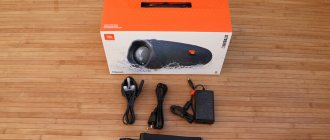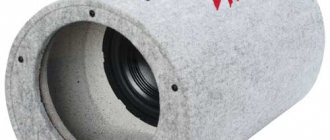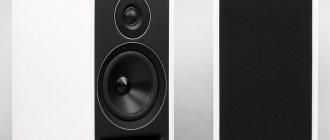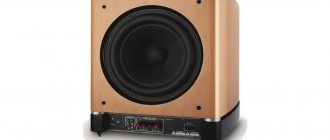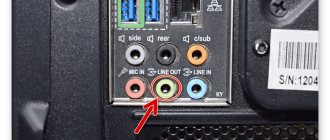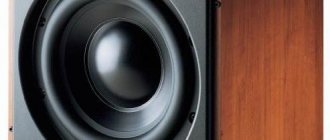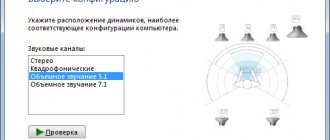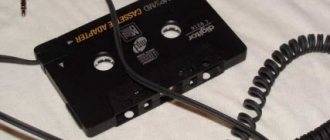Car acoustics are one of those components that are most often subject to changes and improvements, even in new cars. The standard set includes a radio and two speakers mounted in the front doors. But many car owners prefer to replace standard speakers with more expensive ones with better sound quality.
This article will help you choose high-quality car speakers. It discusses the main types of equipment and the best models that are highly rated by users.
Types of car acoustics
Car acoustics are divided into two types: coaxial and component. But the simplest option is full-range speakers. They are inexpensive, but do not have high-quality sound.
Technical help! Full-range speakers have only one cone that reproduces the entire frequency range. This causes noise and wheezing, especially at low frequencies.
To ensure the sound of car speakers is clear and high-quality, it is better to buy coaxial or component speakers. They have several important differences that should be considered in more detail.
Coaxial car audio
This type of car acoustics consists of several dynamic heads located on one housing. As a rule, from one to three high-frequency speakers are installed on a woofer.
The main advantage of coaxial speakers is that, at low cost and easy installation, they can improve the sound of standard full-range speakers.
Despite the fact that coaxial acoustics are better than a conventional radio, they are still inferior in sound quality to component models.
Component car audio
The name of component acoustics reflects its technical features. It consists of several individual speakers and a crossover. Standard models are made from two speakers, but for more surround sound their number can reach up to five.
The advantage of the system is that the car owner can independently choose the location of the speakers. Such acoustics are more expensive, and their installation requires certain skills, but these difficulties are compensated by high sound quality.
What to look for when buying coaxial speakers for cars
Coaxial acoustics is a system that consists of several speakers. The cabinet contains loudspeakers, each of which reproduces specific frequencies, but together they provide a full range.
Speaker sizes
Companies produce round and oval speakers, each option has several sizes. Before purchasing, you need to measure the dimensions of the places for acoustics (diameter and depth). This will ensure the speakers are properly secured. Manufacturers use the following shapes and sizes for speaker systems:
- Round. The main diameters of the columns are 10, 13 and 16 cm. They are usually mounted in doors.
- Oval. Dimensions of the devices are 15x23 cm. Placed on the rear shelf.
The review considers only the most popular models with a diameter of 13 and 16 cm.
Number of lanes
The more bands in the acoustics, the better the sound quality and the more uniform the frequency range. For each frequency (high, mid, low) you need speakers that optimally reproduce that range. In coaxial models, all speakers are located in a common housing, while component acoustics use a separate speaker layout.
In a two-way system, the main woofer/midrange loudspeaker is located at the bottom of the basket (the base of the speaker). There is a tweeter (high-frequency speaker) on a special platform in the center of the case. In three- and four-way models, a different design is used: on the platform with the tweeter there are additional midrange speakers. To separate frequencies in the column, a special device is used - a crossover. But the sound also depends on the materials the manufacturer uses and the quality of the build.
Acoustic power
This is an important parameter when purchasing car audio. For advertising purposes, companies often indicate the maximum power value on speaker packaging, but when choosing devices you need to focus on the nominal (real) power.
frequency range
Equally important are the frequencies that the speakers reproduce. For human hearing, the available range is from 20 Hz to 20 kHz. When using two-way coaxial systems, the lower range starts from 50–100 Hz, in three-way models – from 35–50 Hz. High frequencies are from 18000 Hz and above.
Sensitivity
This value shows the volume of the acoustics when an input signal is received from the amplifier. The higher the sensitivity, the better the volume and sound quality. The indicator is measured in dB (decibels). When connecting speakers directly to a car radio (without using an additional amplifier), it is recommended to choose models with values from 88–90 dB.
Peculiarities
Coaxial acoustics have differences compared to component systems that are important for the buyer to know:
- Location . Speakers are usually placed in the rear of the car.
- Construction . Several speakers are combined in the speaker system housing.
- Direction of sound . The speakers are grouped, the sound panorama is not very spacious.
- Installation . Simple installation of speakers, accessible to most car enthusiasts.
- Price . The systems are inexpensive to produce and therefore profitable to purchase.
Coaxial systems are popular with most buyers. Main advantages: good level of music playback, ease of installation, affordable cost compared to component acoustics.
The best component speakers for a car
Component speaker systems are more expensive than coaxial ones, but their sound will pleasantly surprise even the most demanding music lover.
If you believe user reviews, the three models described below are considered the best.
Hertz MLK 1650.3
The acoustic system consists of a 16-centimeter midbass and a 28-mm tweeter. Both speakers have their own characteristics. The midbass is equipped with a proprietary V-Cone diffuser made of polymer reinforced with cotton fibers.
Tweeter with Tetolon diffuser. The rated power of the system is 150 W. The sensitivity of the device is 90 dB. The indicator is not the highest, but the speakers do not distort sounds at either low or high frequencies.
Pros:
- clear sound without distortion;
- good sensitivity;
- frequency range 40-28000 Hz.
Minuses:
- no protective grille;
- complex installation of tweeters.
Price: 49,900 rubles.
Hertz MLK 1650.3
Morel Virtus 603
Users praised the sound of the speakers, but many complained about the difficulty of installation. The speaker system has a 60mm silk mid-range driver. It includes a 20mm rotary tweeter with a silk cone.
The diffuser on the midbass is made of paper with special impregnation - the equipment will not be damaged by high air humidity. The frequency range is worse than that of analogues (55-22000 Hz), but this is enough for comfortable listening to music in the car.
Pros:
- detailed surround sound;
- there is no pronounced directionality in a wide band, which greatly facilitates installation;
- the cost is lower than analogues.
Users consider the diffusers to be sensitive to damage as a disadvantage of the model.
Price: 29,900 rubles.
Morel Virtus 603
Focal 165 KRX2
The two-way speaker system consists of a 16 cm mid-range speaker and a 20 mm tweeter. Rated power is 100 W, and sensitivity is 93 dB. This is enough for high-quality music playback in the car.
Frequency range – 70-20000 Hz. This is a little lower than its analogues, but the speakers work well at high notes without distorting the sound and accurately draw out the nuances of audio tracks.
Pros:
- high-quality playback of tracks with complex sound;
- high sensitivity.
Users consider the crossover to be too simple a disadvantage of the model.
Price: 36,000 rubles.
Focal 165 KRX2
How to choose the best coaxial speakers
Acoustic installation
Proper placement of the speakers in your vehicle is important for optimal sound.
For coaxial speakers, there are several recommendations that should be taken into account during installation. Let's look at the basic information. The dimensions of the coaxial speakers correspond to the standard dimensions for acoustics. Popular sizes are 13 and 16 cm. These round speakers are usually placed in car doors. Manufacturers also produce oval models, which are best secured in the luggage rack.
The acoustics are easy to install. The user does not need to place additional components in the cabin: tweeters, crossovers, connecting cables. The speakers need to be fixed and connected to the car wiring.
Coaxial acoustics are the best option for car audio equipment. Such systems provide a good level of playback of songs. The devices are recommended for novice car enthusiasts who want to improve the sound of standard speakers. Connoisseurs of professional sound usually choose a different class - component acoustics.
Technical information on devices
A diffuser is a membrane that creates sound in an acoustic system. An electrical signal from the amplifier goes to the speaker, and the diffuser creates vibrations that are perceived by the ear as sound. The materials from which speaker cones are made have certain properties. This is rigidity and elasticity. For optimal acoustic sound, you need a balance of these parameters. The following materials are used in coaxial acoustics: polypropylene, composites, silk and other materials. You can read more detailed information in our review.
The suspension is a structural element of the speaker that allows the diffuser to move. The lower suspension is located at the base; it is a central washer made of cotton or acrylic fabric. The upper suspension is called corrugation and is located on the outside along the perimeter of the diffuser.
Impedance is the electrical resistance of a speaker, measured in ohms. This parameter does not affect the sound quality, but must be taken into account when connecting acoustics to an amplifier or radio.
Optional equipment
A crossover is a device that divides the input signal from an amplifier into several frequency ranges. Coaxial speakers use a small built-in crossover.
An audio receiver (car radio) is used to adjust the sound settings in the cabin, select songs, and control acoustics. For optimal sound reproduction, you need not only good speakers, but also an audio receiver with a high-quality built-in amplifier. Top-end devices are compatible with various acoustics (coaxial and component).
The built-in amplifier is located in the audio receiver housing. From the amplifier the signal goes to the speaker systems. The power of the built-in amplifier is enough for basic tasks; many car enthusiasts like this option.
Comparing the best models
A comparison table with prices and main technical characteristics of the models given above will help you choose car speakers.
| Model name | Price, rubles | Standard size, cm | Rated power, W | Speaker size (HF/LF), mm | Sensitivity, dB |
| Pioneer TS-1339 | 1700 | 13 | 35 | 10/42 | 91 |
| Infinity REF-6522ix | 3000 | 16 | 60 | -/160 | 93 |
| Vorel Tempo Coax 6 | 4000 | 16 | 110 | -/165 | 90 |
| Focal 165 AC | 6100 | 16 | 60 | -/165 | 91 |
| Hertz MPX 165.3 | 13200 | 16 | 100 | 25/165 | 92 |
| Morel Virtus 603 | 29 900 | 16 | 140 | 60/165 | 88 |
| Focal 165 KRX2 | 36 000 | 16 | 100 | 51/165 | 93 |
| Hertz MLK 1650.3 | 49900 | 16 | 150 | 28/165 | 92 |
Coaxial speaker system
The simplest and cheapest option for installing an audio system is to purchase coaxial speakers, the design of which includes several speakers. The reproduced range is divided into sections. A separate device is responsible for playing each part of the range.
The signal is separated using specialized filters (crossovers). Depending on the model of the speaker system, certain crossovers are used. More expensive coaxial models are equipped with crossovers in separate housings; in budget models, the crossover is an ordinary capacitor (the simplest filter) in the device housing.
Tags: connection, component acoustics
Comments 24
You feed everything the same from the amp to the crossover, and from the crossover you throw it into the middle and the tweeters and everything will work for you, but in general, throw it away and buy normal dins
turn it on channel by channel - it will work best on your components. In the last picture you can have 4 channels (instead of 3 channels). Connect the tweeters through the included crossover from GU.A mids from a 4-channel amplifier 1 pair and the second pair from sub to sub. And the tweeters and mids are the front, and the rear is only the sub!
Everyone suggests this, it turns out that there will be nothing behind me except bass ((
You don't need the rear ones, believe me.
Well, for now I’ll put it this way, then I’ll have to buy a tiny one
Everyone suggests this, it turns out that there will be nothing behind me except bass ((
At a concert, do you stand with your back to the musicians? - The stage should be in front - this is an axiom. Low frequencies (up to about 100 Hz (even more at about 200) - which is what the sub plays) - the human ear cannot localize (determine where it is playing from).
You need to take a photo of the crossover, where the labels for the terminals will be visible. You can send me a photo in a PM. I'll help you with the connection. And post a photo of the amplifier, we need to see your amplifier settings.
Thanks, I'll do it a little later. OK?
PM me as soon as you can
Your scheme is not very good. It will work if you put both the sub and the pancakes on one output
I don’t understand this)) I just drew it as it sits in the car now. It plays very poorly, the horns on different speakers burst, the crossovers on the dls melted, and this is all after the master installed it. Now these misters have appeared and I want them with the rear speakers to give out their voice, the tweeters to squeak and not burst, and the subwoofer to be bassy. The scheme can be changed if there is one.
You got a master from God... or rather, God forbid something like this... The schemes are simple. You can handle it yourself. 1. If you have a 4-channel amplifier. A) front components, rear sub. B) front component, rear pancakes...if you want a sub, then this is either a 5-6 channel amplifier. Or separately to a sub 1-2 channel amplifier. C) many will consider it a slight perversion. Front component. Behind the subwoofer there are pancakes to the radio. Definitely on the outputs for the rear speakers.
Installation of component acoustics - assortment
The choice of component acoustics is huge, and the car owner is unlikely to have problems finding the necessary set in the required price category. The cost of component kits varies very widely - from one thousand to several hundred thousand rubles. Of course, kits in the highest price categories are of interest to a very limited number of car owners - those who want to build a truly high-quality and individual acoustic system, and are ready to spend serious money. More often, the buyer's choice is focused on low and medium price categories, in which the main assortment is presented.
In any specialized online store, a visitor can see offers from dozens of manufacturers, including many well-known and not so well-known. Well-known brands in this area are DLS, Focal, Hertz, JBL, Kicx, Morel and some others. Some manufacturers produce speakers exclusively, while others specialize in the entire range of car audio equipment. The range of some brands contains only budget sets, while others try to cover the maximum number of price ranges. Manufacturers such as Focal, Audison, Morel have high-quality kits in their lines that may be of interest to true car audio fans.
The cost of a specific kit depends on many parameters - brand awareness, technical characteristics, quality of materials (from which the components are made), acoustic class. In addition, each brand has its own individual sound characteristics, which is very important when building a high-quality acoustic system in accordance with the preferences of the car owner. That is why it is advisable to seek the help of specialists from specialized installation centers who will not only select the required equipment, but also carry out its high-quality installation.
Do I need a subwoofer, or can I get by with 6x9 speakers?
To reproduce deep low frequencies, you need to purchase speakers with a large cone area. To get high-quality bass, it is better to install devices in front with a diameter of not 13, as is the case in standard speakers, but 16 cm. To be completely honest, the lowest frequencies will still be lost, since they can only be obtained by installing a subwoofer, which is precisely what is responsible for the execution of the “lower classes”.
At the same time, you don’t have to buy a subwoofer, an alternative to which would be 6x9 inch speakers, which also cope with deep bass reproduction at a high level. Naturally, this is not an equivalent replacement, since they cannot sound loud and low at the same time, but these are universal speakers that can cope with the entire musical frequency range - from the highest to the lowest. When choosing such speakers, you should not strive to buy devices with a large number of bands - two-way or three-way speakers will be enough to reproduce bass.
Main selection criteria
When choosing and purchasing component acoustics, you should focus your attention on the following parameters:
- Dimensions suitable for the installation space;
- Power. You cannot install acoustics whose power is less than the final amplifier of the radio;
- Active resistance, there are two options: 4 or 8 Ohms, this indicator must be consistent with the equipment reproducing sound;
- Operating frequency range and number of components.
The price of a particular kit depends on several factors:
- brand awareness;
- technical characteristics;
- quality of materials and components;
- acoustics class;
In addition to the listed criteria, each acoustics manufacturer has individual sound characteristics, which also need to be taken into account in accordance with the preferences of a particular music lover who is selecting equipment.
Good evening! I'm not good at music at all, but I need to connect the components. In the diagram below I drew how it is connected and what needs help to connect. Thank you in advance.
